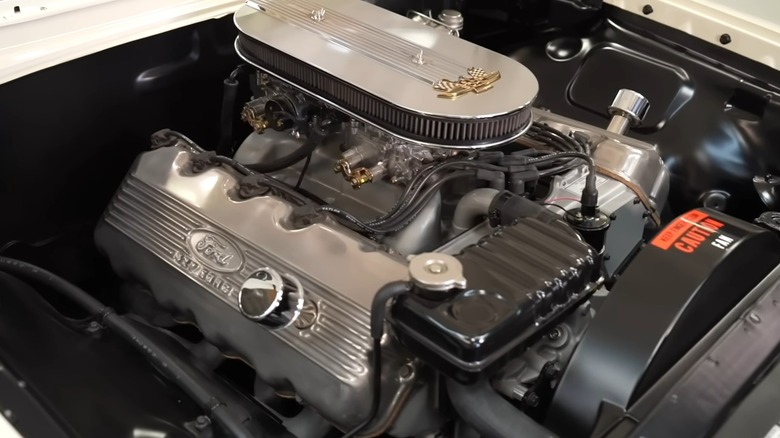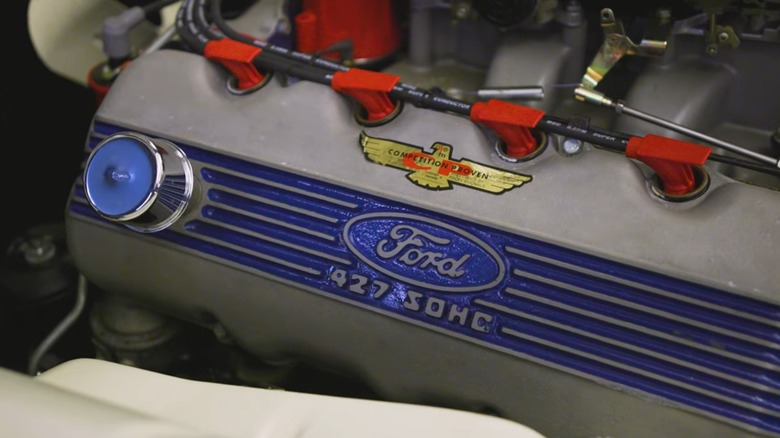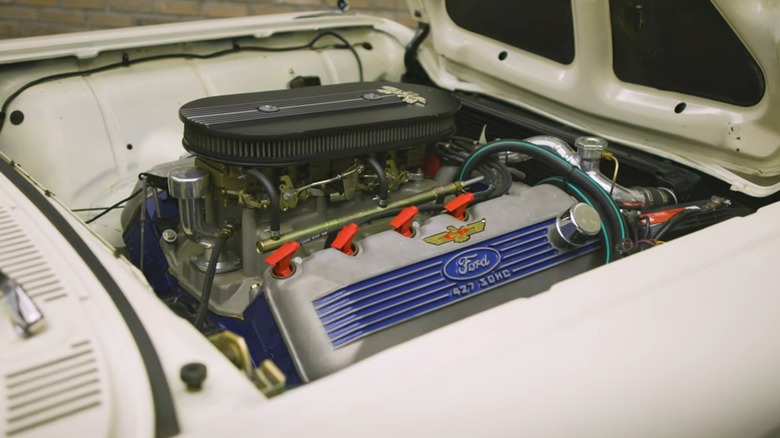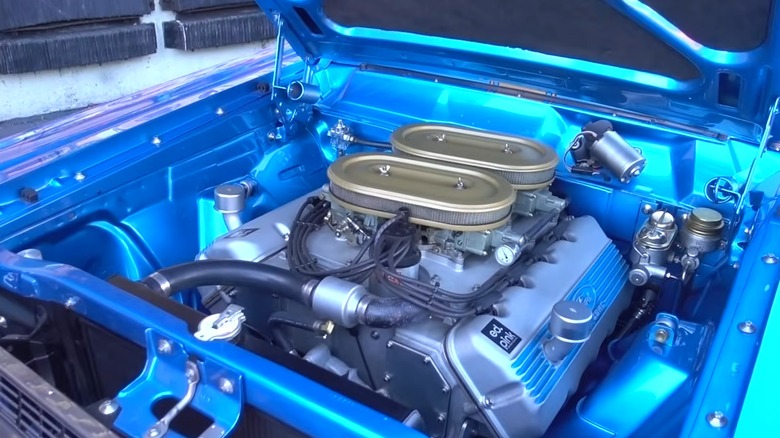Everything To Know About Ford's Legendary 427 SOHC Engine
For automakers, the 1960s were a time of unbridled power and speed. Prior to the arrival and widespread implementation of emissions control devices in the 1970s, car manufacturers were pumping out a seemingly never-ending series of muscle-packed, high-power vehicles. Some of the most iconic muscle cars of all time were produced during this period, like the 1969 Dodge Charger and the 1967 Chevrolet Camaro.
That desire to produce faster and more powerful engines was fueled, in part, by the rising popularity of motorsports like NASCAR and drag racing. One NASCAR race, in particular, was responsible for the development of a fierce rivalry between two of the United States' most popular automakers — Chrysler and Ford. In the 1964 Daytona 500, Ford suffered an embarrassing defeat to drivers operating racecars powered by the Chrysler 426 HEMI. The Plymouth drivers finished in first, second, and third place, handing Ford a devastating loss and causing the company to radically rethink its engine strategy.
Ford's response was to build an even bigger and better motor in just three months. Dubbed "The Cammer," thanks to its innovative single overhead camshaft (SOHC) design, the 427 engine took the racing world by storm. In the years that followed, the 427 SOHC engine would go on to achieve legendary status. It was the subject of intense debate in the world of NASCAR and the inspiration for countless racecars that followed it. From its birth in the ashes of defeat to its rise to become one of Ford's most impressive engines ever built, here's everything you need to know about Ford's 427 SOHC engine.
The Cammer: Ford's answer to the Mopar HEMI
In the wake of its humiliating loss to the three Mopar drivers, Ford's development team jumped into high gear to produce an engine capable of competing with the legendary Chrysler HEMI. The automaker's answer was a 7.0-liter, 426-cubic-inch displacement engine. It used the same block as Ford's earlier 427 FE V8 but incorporated numerous performance upgrades to improve power output. Some of those upgrades included an enhanced lubrication system, modified main bearing caps, and an extra idler gear added to the camshaft. However, the most significant change came in the form of the dual-valve, single-overhead camshafts and the six-foot timing chain that spun them. The SOHC design enabled Ford to improve engine performance by enlarging the intake and exhaust valves, allowing more air to enter the combustion chamber at one time while simultaneously allowing more exhaust fumes to escape.
The result of Ford's three-month endeavor was a 616-horsepower Mopar-destroyer. However, while Ford succeeded in building an engine capable of competing with the Chrysler HEMI, NASCAR had other plans. In October 1964, NASCAR made the decision to ban "special racing engines," including the Chrysler HEMI and the Ford 427 SOHC motor. The Mopar team decided to boycott NASCAR in protest. Ford, on the other hand, continued to compete with its old 427 engine while exploring alternative applications for the powerful Cammer.
Beyond NASCAR: The Cammer stretches its wings
NASCAR's special racing engine ban prevented Ford from exploring the Cammer's limits on the track, but Ford didn't give up hope. Instead, the automaker shifted its focus from the circuit track to a quarter-mile straight line. Ford reached out to several top drag racers of the day, including Connie Kalitta, Tom Hoover, and Pete Robinson. The company provided engines to race teams across the country, allowing each team to customize and modify the motors in an attempt to dominate the drag strip.
Ford's gamble paid off. In 1965, Connie Kalitta hit 200 miles per hour in his Cammer-powered car, setting an AHRA record and cementing the Cammer's place in motorsports history. In the years that followed, the 427 SOHC motor continued to dominate the drag strip, and race teams continued to improve the Cammer. Bill Lawton, another Cammer driver, won both the NHRA and AHRA Winternationals by early 1966, while Pete Robinson went on to win the 1966 NHRA world championship in his Cammer car. Throughout the '60s, the Ford 427 SOHC motor dominated the drag strip, and the engine would achieve legendary status during this time.
The Cammer: the legend continues
NASCAR eventually unbanned "special racing engines" in 1966. But while the Cammer was finally allowed to compete, it would have to do so with extreme weight handicaps, resulting in Ford's decision to continue focusing on the drag strip. The result of this decision was near-complete domination of the quarter mile during the late '60s. While the engine was eventually replaced by the Boss 429, the Cammer solidified its position as one of the greatest V8 engines ever made.
Today, original Cammer motors are extremely rare. If you find one, you'll likely have to pay a pretty penny to make it yours. Instead, there are a few companies producing Cammer replicas. The motors are still fairly pricey, but these companies provide one of the best ways to get your hands on a Cammer, whether you have plans to build your own custom hotrod or simply want to own a classic piece of motorsports history.



